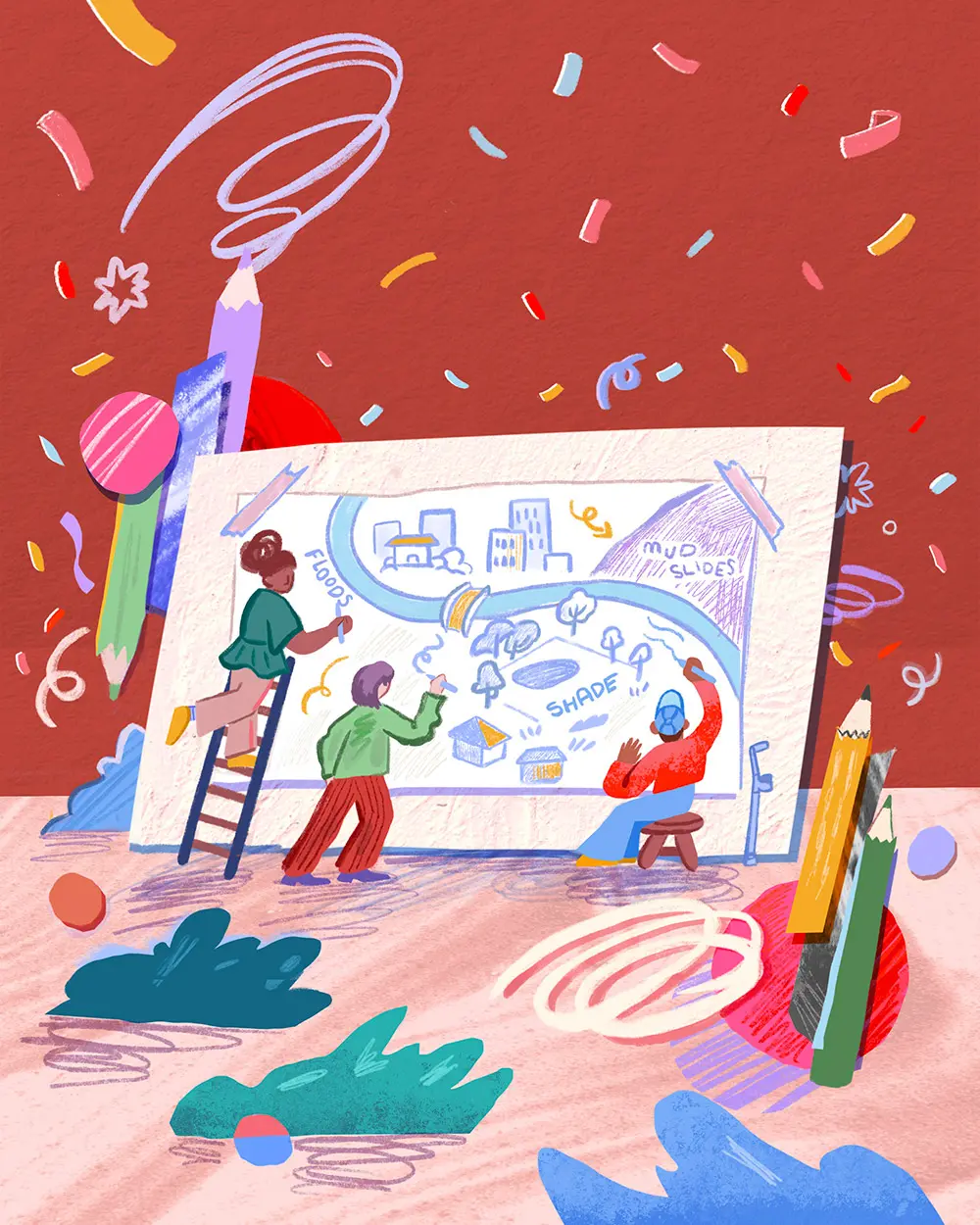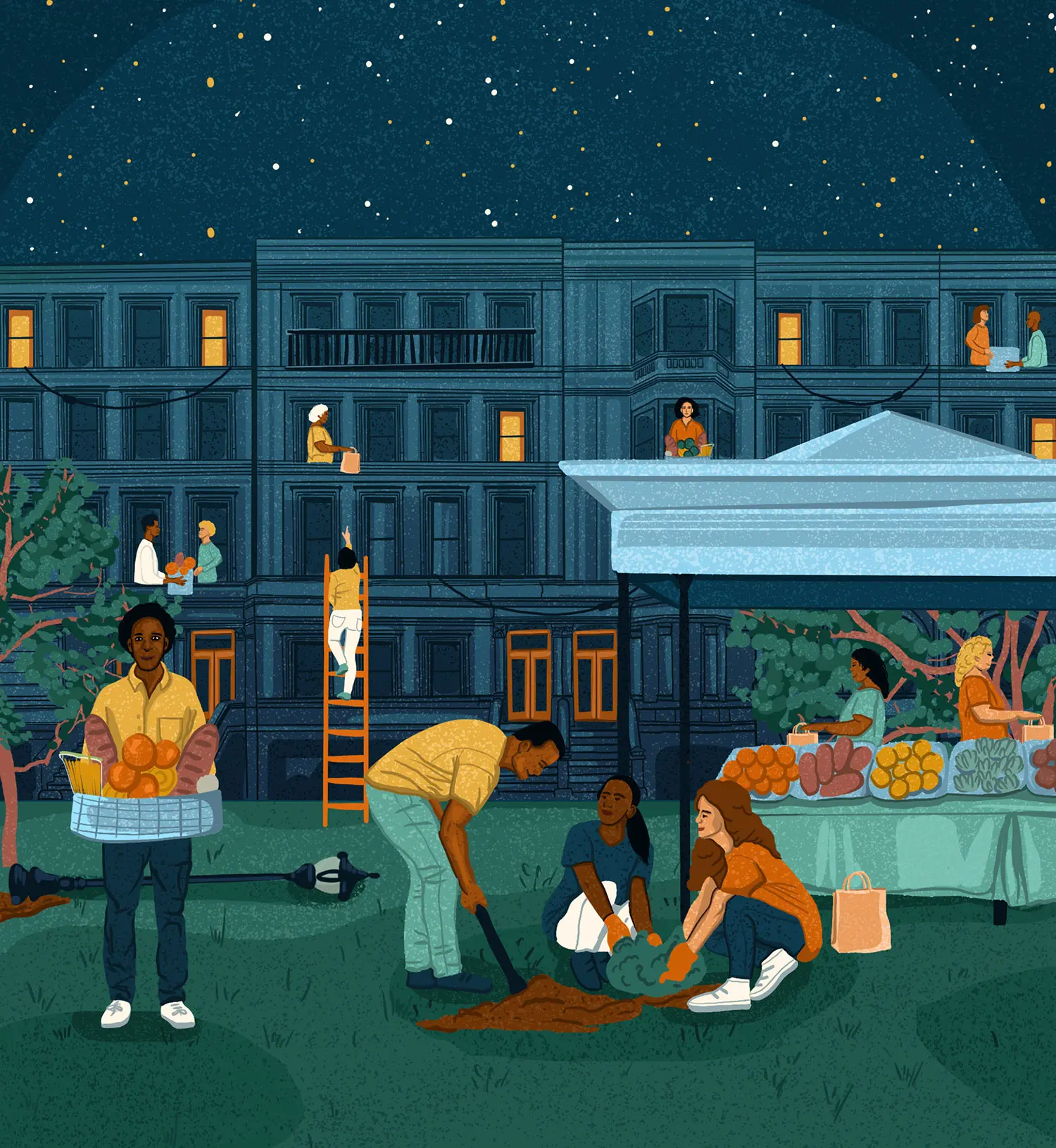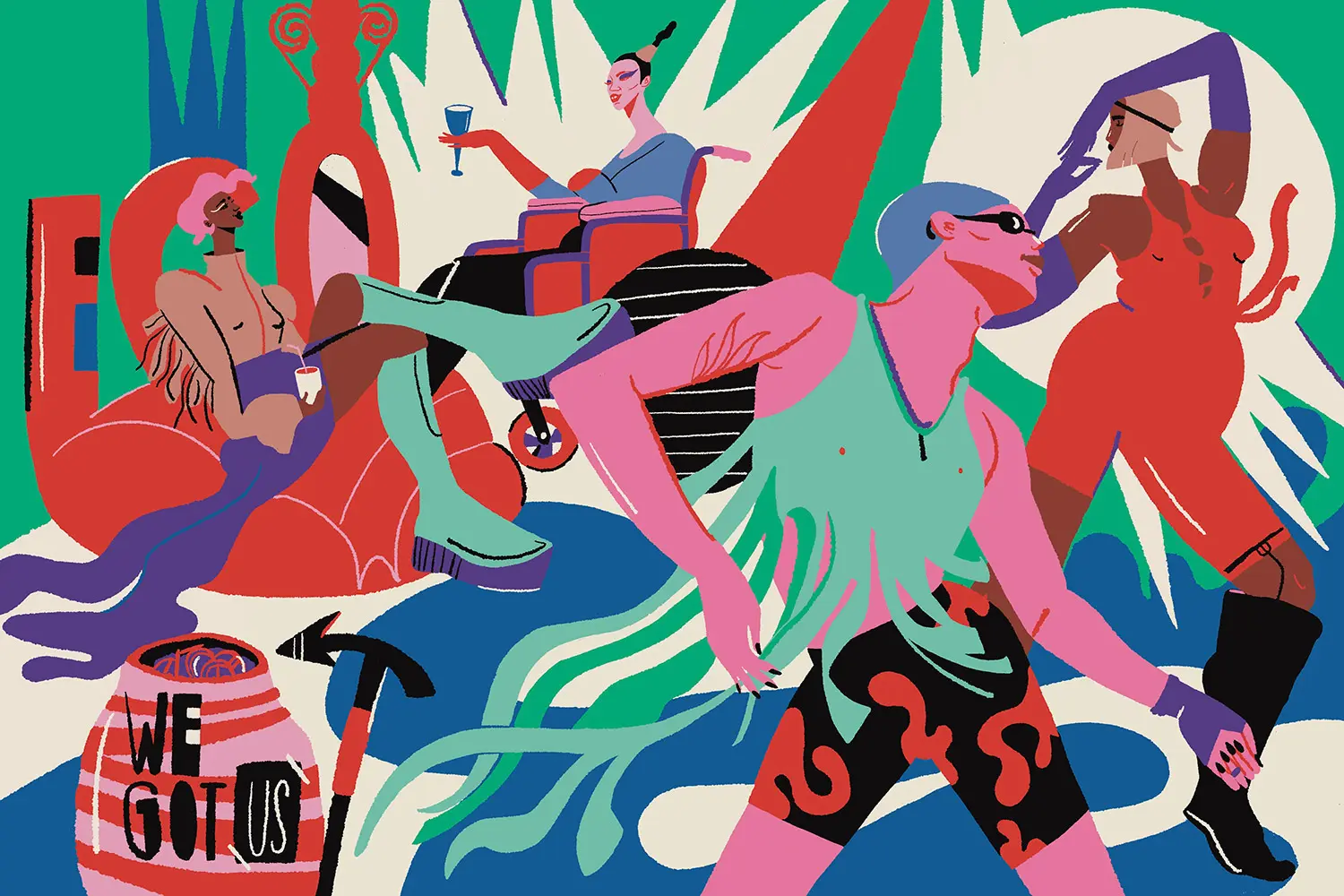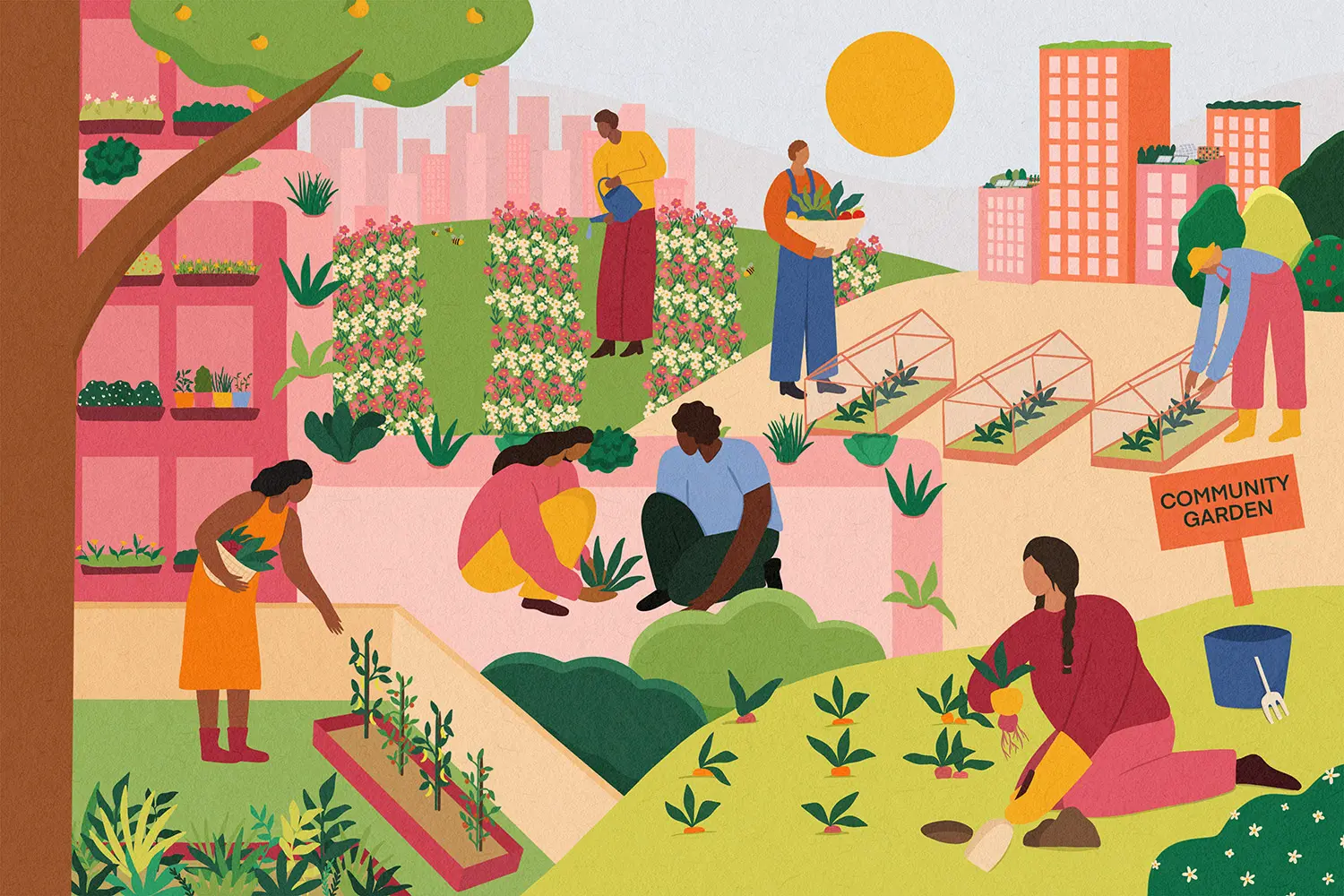Climate resilience as Community Science
Community Science is a powerful tool to:

What it is: Community science—sometimes described as citizen science, participatory action research, participatory monitoring, or public participation in scientific research—refers to a model of data collection and knowledge sharing that is community-led and community-controlled. It’s intended to enhance local knowledge and understanding, increase scientific engagement and accessibility, help identify solutions, and inspire collective action.
Some additional context: While community science has surged in popularity in recent years, particularly as the internet has made it easier to crowdsource data, the origins of the community science framework go back at least a couple of millennia; there’s evidence of residents of ancient China tracking migratory locust outbreaks to help inform agricultural practices more than 2,000 years ago. Citizen science was actually arguably the default form of science until quite recently. On the Youtube channel SciShow, host Hank Green explains, “A couple centuries ago, science was mostly an informal, collaborative kind of enterprise. Scientists were pretty much people who would think and write about our world to explain why things are the way they are… But starting in the 19th century, science became a full-time career for lots of people, because that’s when money started to become available from governments and schools to do research. Suddenly, in order to be a “professional” scientist- and make a living doing research- you had to distinguish yourself from all the curious hobbyists out there. And when the idea of a professional scientist was born, so too was the idea of the amateur scientist.” It became increasingly difficult for the research of so-called “amateur scientists” to be respected and taken seriously. Today, more and more people are once again recognizing community science as valid and important.
Community science differs in a handful of ways from scientific research conducted exclusively in academic, government, and corporate spaces:
- Community science may include western scientific research methods but can also draw from lived experience, Traditional Ecological Knowledge, ancestral knowledge, and community identified solutions. Community science recognizes multiple ways of knowing as valid and important.
- Community science projects oftentimes explicitly center liberation, reclamation, and justice and are rooted in collaboration, consent, co-learning, and self-determination.
- Rather than studying communities as a problem to be solved or dealt with, community science is a human-centered approach to problem solving that works with community members to identify and mitigate specific points of harm. Community science resists exploitation by scientists and the scientific process (though many community science projects are in collaboration with professional scientists and scientific institutions).
- Community scientists may not have formal scientific training, though they may have lived experience that makes them an expert on the issue that they’re researching.
“There are signs that the internet and global technology are reviving the role of citizens in documenting how the world around us is changing. Not to undermine the knowledge of experts. Not to engage in some elitist project or define some new kind of geekdom. But to build collective insight—millions of little observations about the now-warming climate, the now-shrinking numbers of species of animals and plants, the chemistry of air and oceans and minerals—that might just help us survive and adapt to the next century.” Madeline Ostrander, science and environment journalist (Source)
Why it’s a climate resilience powerhouse:
Monitoring changes in local climate, ecosystems, and biodiversity
Community science can help fill in the gaps of what’s not being measured, capture much more robust and granular data than would otherwise be possible (the Global Biodiversity Information Facility has collected billions of data points from community scientists, informing more than 7,000 peer-reviewed papers!), and improve public understanding of issues that affect them. Particularly as the climate crisis and intertwined crises rapidly shift weather, transform landscapes, and impact biodiversity, having copious amounts of real-time data is crucial in helping to discern what’s happening, why it’s happening, and what can and should be done. Community science projects have bolstered collectivist insight around everything from bees and bears and butterflies to pollution from oil refineries, air quality level during wildfires, indoor and outdoor temperatures during heatwaves, rainfall measurements during storms, and so much more. For instance:
- The Indigenous Sentinels Network (ISN) emerged twenty years ago to support the Aleut Community of St. Paul Island, Alaska in monitoring environmental conditions and wildlife. The ISN has evolved to provide dozens of remote, Indigenous communities with the tools, training, networks, and capacity necessary to monitor rapidly changing ecosystems utilizing both western scientific methods and Traditional Ecological Knowledge. They’ve developed a suite of mobile data collection apps that work without WiFi or cell coverage (which is important in remote communities) and an easy-to-use database, trained and hired Indigenous folks to collect data in their own communities, and forged partnerships in order to help inform local and regional management, planning, and policy. ISN is a fantastic example of an initiative that helps to fill in critical data gaps, embraces multiple ways of knowing, prioritizes data sovereignty and community ownership of information, deepens collective insight around climate and environmental issues, empowers community members to help shape solutions, and even creates good, local jobs in the process.
“Now nearly every looming crisis our society faces is at least partly a scientific one. The colossal emergency of climate change, the problem of feeding the couple billion additional people who might populate this planet in the next couple of decades, the collapse of ocean ecosystems, the rise of the next epidemic disease. Problems as large as this will require ingenuity, labor, and support beyond just the professional scientific community.” -Science and environment journalist Madeline Ostrander (source) Madeline Ostrander, science and environment journalist (source)
Holding perpetrators of climate and environmental injustice accountable
Community science is a particularly potent tool in areas where denialism and/or gaslighting around climate and environmental issues are pervasive, as it enables folks to gather hard data for themselves, resist disinformation, reclaim the narrative, and take action to right wrongs. For instance:
- A grassroots community science project in Belmont County, Ohio was able to fill in the gaps of EPA air quality data to more accurately capture the impact fracking-related pollution (over 700 oil and gas wells were drilled in Belmont County between 2011 and 2021). Residents were experiencing symptoms of toxic air pollution, like frequent headaches, nausea, fatigue, and trouble breathing, and suspected that fracking operations might be releasing toxic pollution into the air, but EPA’s air pollution monitoring didn’t detect anything out of the ordinary (it’s important to note that EPA’s air pollution monitoring consisted of three sensors spread out across a county that covers nearly 550 square miles). So, residents decided to collect data themselves. Folks at Freshwater Accountability Project and Concerned Ohio River Residents solicited support from Thriving Earth Exchange and connected with researchers from several universities and community advocacy organizations. Together, they developed a community network of air monitoring stations using relatively inexpensive PurpleAir sensors, which picked up high levels of benzene, toluene, and fine particulate matter. They were able to map plumes of pollution coming from a nearby natural gas plant and show how wind patterns could influence pollution spikes. Community scientists also kept logs of physical symptoms and other things that they noticed, and ultimately found that the spikes in emissions that the air sensors picked up mapped closely with those logs. Lea Harper, the managing director of the Freshwater Accountability Project, reflected, “Prior to the study, many in Belmont County downplayed their own symptoms, feeling that nothing could be done about them. Others denied that fracking – a major economic force in the region – had any negative impact on Belmont’s air quality… To have at least some ability to verify and validate people’s concerns has been much more empowering than anything I was able to do before.” She’s excited that the data they were able to collect will be helpful in organizing residents and potentially taking legal action against polluters and preventing fossil fuel projects in the future.
- Louisiana Bucket Brigade uses community science to measure toxic gases in the air and hold industry and government accountable. Louisiana Bucket Brigade, founded in 2000 to help address the petrochemical industry’s devastating impact on the region known as Cancer Alley, trains community members in fenceline neighborhoods to use effective but cheap and easy-to-use air sample buckets to conduct hot spot monitoring when they’re worried that they’re at risk of toxic chemical exposure from nearby oil refineries, plastic plants, and chemical facilities. Louisiana Bucket Brigade explains that “community members who live next to oil refiners and chemical plants are constantly told by industry officials that their operations are safe and that the air is healthy to breathe,” despite an intentional lack of consistent and thorough air quality monitoring (they elaborate that the government’s “placement of monitoring stations is a decision made in conjunction with industry, which often pushes for strategic locations that see the least amount of pollution”). Citizen bucket brigades are therefore an effective tool of resistance for community members to prove that the air they’re breathing is not in fact safe and healthy—and to demand meaningful action. Thus far, Louisiana Bucket Brigade has successfully organized with residents and other community-based organizations to negotiate buyouts of contaminated neighborhoods, expand air monitoring and government oversight, and prevent industry expansion that would increase toxic pollution and greenhouse gas emissions (you can read more about their copious victories here). To support Louisiana Bucket Brigade’s work, consider making a donation

- For over a decade, the Pesticide Action Network (PAN) has been partnering with community-based organizations in farming communities in states like Hawaii, California, Minnesota, Wisconsin, and Illinois in order to test the air for pesticide drift and advocate for change. Community members and farmers use PAN’s Drift Catcher air monitoring device to take air samples when nearby farms are being sprayed with pesticides. They then send samples back to PAN to be studied for traces of certain toxic chemicals. They use this information to organize accordingly and fight back against Big Agriculture. The data gathered by community scientists has helped to ground lawsuits against agrochemical companies and bring about real policy change. For instance, in Kauai, residents won a lawsuit against biotech giant DuPont-Pioneer for exposing their communities to extraordinarily high levels of pesticides linked to a range of serious health issues, and in both Hawaii and California, PAN worked with grassroots groups to pass statewide bans against chlorpyrifos (now banned nationwide) and win buffer zones around schools to protect children from brain-harming and cancer-causing pesticide drift.
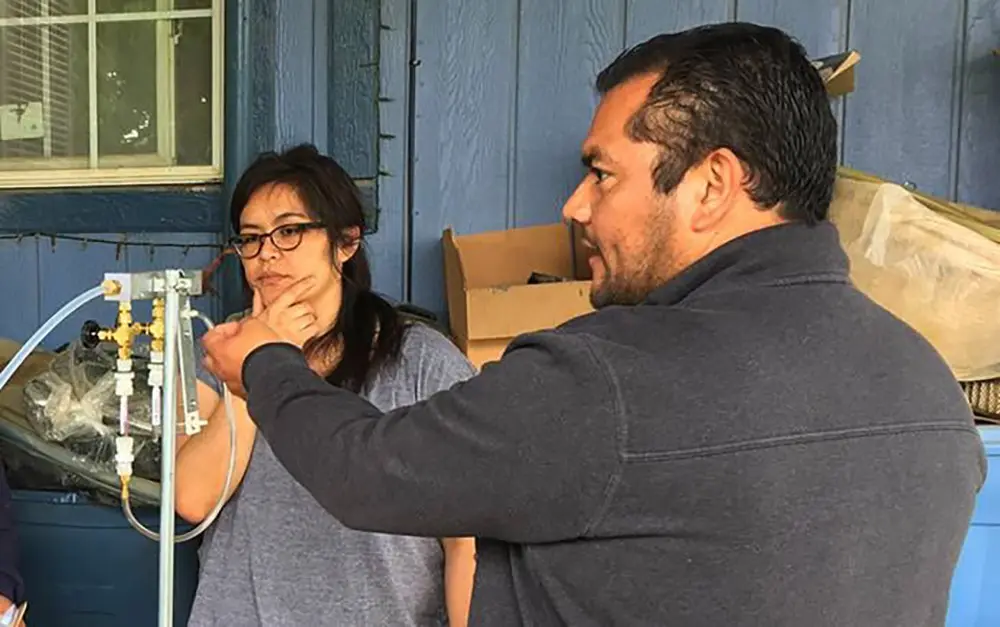
Informing effective and just solutions
Community-led and community-controlled solutions are a natural extension of community-led and community-controlled scientific projects. Rather than relying on interventions to be determined and implemented by academic institutions and governmental agencies, who have been and continue to be responsible for tremendous harm to structurally oppressed communities, community science enables community members to identify best practices themselves.
Not only can community science be a helpful tool in the reclamation of power and self-determination, but it makes for better solutions, too. Solutions are far more likely to be effective and sustainable in the long run when they are informed by robust, granular quantitative data as well as lived expertise, when residents are in the driver’s seat to shape solutions themselves, and when they are implemented at the appropriate scale (founder and CEO of ISeeChange, Julia Kumari Drapkin, says that community science has taught her that “the solutions are almost as granular, in some cases, as the threat”). For instance:
- Harlem Heat Project, a community-based initiative that began in 2016, helped folks to better understand the public health impacts of summer heat on Harlem, New York’s residents without air conditioning as well as to identify community-led solutions. The project was a collaboration between many; the data and engagement platform ISeeChange provided the infrastructure to collect data, local residents, also known as the community scientists, collected the data and shared their lived experience, research scientists from nearby universities helped to model data and provide scientific support, organizations with deep community roots, like WE ACT for Environmental Justice, helped to facilitate community engagement and policy advocacy efforts, and local news stations helped to communicate the results. The community scientists were given inexpensive heat and humidity sensors to keep in their homes and were trained to capture and upload sensor data from their smartphones. They were able to capture robust data that demonstrated how outdoor conditions affected indoor temperatures and pointed to important trends (for instance, folks living in public housing apartments experienced the hottest indoor temperatures). Quantitative data was supplemented with community workshops which shed light on how people experienced heat and which solutions would or wouldn’t work. For instance, some community members mentioned struggling to decide whether to open their windows for relief or keep them closed so as not to let in polluted air. Others discussed the complications and extra charges that came with trying to install air conditioning in public housing apartments. The solutions that the community scientists came up with (and that WE ACT then advocated for), like creating more accessible cooling spaces in their buildings and developing better alert systems to remind them to check in on neighbors, were shaped directly from the research that they conducted and from their lived expertise.
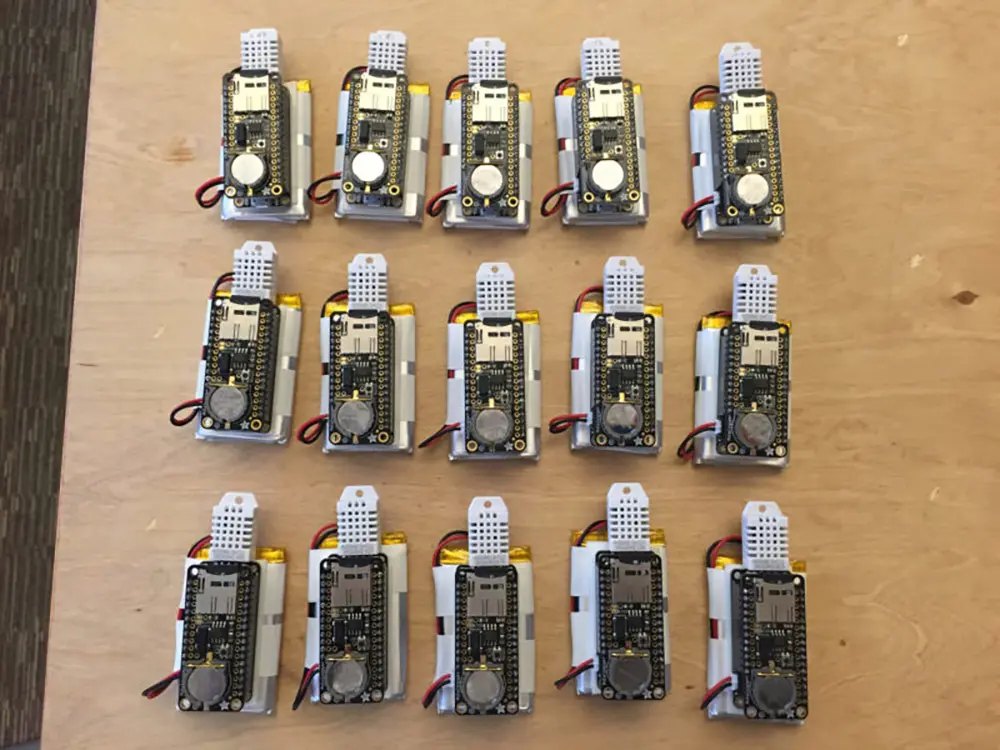
- West Oakland Environmental Indicators Project (WOEIP) is a resident-led environmental justice organization that was founded in 2012 to build people power and equip community members of West Oakland, California with the tools to advocate for healthy homes, healthy jobs, and healthy communities. Their community-based participatory research program is a central part of their work; they help to train both youth and adults to formulate meaningful questions, collect and analyze data, develop solutions, and organize to make change. They have conducted several resident-led studies and partnered with a range of stakeholders, like city and regional planners, regulators, policy makers, and businesses, to ensure that their findings are recognized and that their solutions are implemented. For instance, after decades of conducting local air pollution measurements, truck surveys, and other studies to better understand air pollution on a block-by-block level, WOEIP partnered with the Bay Area Air Quality Management District to develop a comprehensive community action plan aptly titled “Owning Our Air,” in which they identified over 90 specific strategies to improve air quality. WOEIP explains, “In our experience, when community members have personal agency in the decisions that impact their lives, community outcomes are more relevant and appropriate, more meaningful, and longer lasting.”
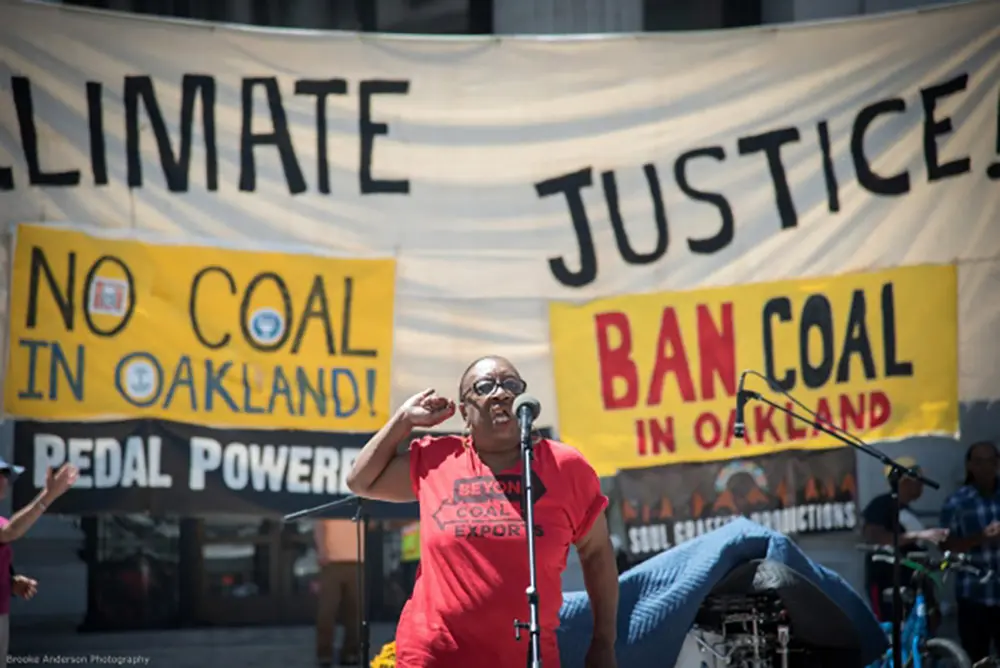
The scientific community is leaning into the idea that science can be an ally for justice, and a tool that communities have as they try to repair or address harms or promote future changes. Rajul Pandya, Vice President of Thriving Earth Exchange (source)
Improving wellbeing and strengthening relationships between community members and their surroundings
Community science also provides a gentle opportunity to get outside and cultivate sustained relationships with the nearby community, including other human and more-than-human members. A 2023 study published in People and Nature found that community science had a significantly positive effect on researchers, bolstering their connectedness with nature, sense of worth, satisfaction with life, and overall happiness. Participants of the study noted that engaging in a community science practice gave them permission to slow down, made them more aware of all aspects of the environment, and deepened their understanding of how spending time in nature affected their mood. When study participants also engaged in nature-noticing activities (in this case, they were asked to note three good things in nature), they were also more likely to engage in pro-nature behavior, such as growing gardens to support pollinators, engaging in political advocacy, and picking up trash in their community.
Continue readingPeople connect with nature in different ways, so it’s great to see nature-based citizen science can provide another form of active engagement that can strengthen the human-nature relationship. When combined with noticing the positive emotions nature can bring, citizen science can help unite both human and nature’s wellbeing. Miles Richardson, Researcher (source)
The nuance / caveats:
Community science is an invaluable tool, and it’s important to keep in mind that data collection alone is rarely enough to make meaningful change. In order to not just reveal problems but also correct them, community science must go hand in hand with organizing. Community science efforts are often most successful in collaboration with grassroots groups who specialize in advocacy and community engagement and can be instrumental in continuing to move the process forward.
It’s also important to note that, unfortunately, community science is often unfairly discredited. For instance, the Belmont County research on fracking-related pollution was conducted in tandem with professional researchers and appeared in a peer-reviewed journal, but a spokesperson for the Ohio Oil and Gas Association wrote it off as politically motivated, saying, “While we respect those conducting citizen science, we strongly disregard a report funded and conducted by those who oppose the natural gas industry whose conclusion is anti-natural gas,” adding that he stands by the EPA’s monitors and their data, which is far less thorough and conveniently has not indicated problematic pollution levels. There is more work to be done to ensure that community science initiatives are recognized as legitimate.
Continue readingResearch + reflection prompts:
- Are there any community science projects in your area that interest you? Global Biodiversity Information Facility, SciStarter, CitSci.org, Public Lab, and CitizenScience.gov are among the several databases of community science projects worth exploring.
- Which modes of knowing and understanding the world were most important to your ancestors? Which modes of knowing and understanding the world around you resonate the most with you?
- Which phenomena, issues, or beings in your community would you like to better know and understand?
How to get engaged:
Observe weather and climate
If you’re interested in deepening your understanding of local weather and how it’s changing: Tap into the ISeeChange network, a data collection and engagement platform. Simply observe weather and climate near you and describe what you’re observing and how it’s affecting you, and the platform creates a community record syncing with weather data and trends, which will help to guide the work of climatologists, social scientists, urban planners, engineers, and health professionals.
Explore surrounding ecosystem
If you’re passionate about the more-than-human members of your community: Explore social networks like INaturalist, which allow you to share photos of flora and fauna for community identification and discussion and can help to track changes in the surrounding ecosystem. INaturalist also has a Projects feature that allows people to pool their observations with others. Consider starting your own or join an existing project in your area.
Monitor your community
If you’re passionate about something specific in your community: Begin monitoring it on a regular basis, on your own or with neighbors or friends. Perhaps you’ve been noticing a shift in weather patterns or the physical environment that you’d like to follow more closely, or there’s an environmental injustice occurring in your community that you’d like to have more robust data to share, or there’s a plant or animal relative that you would like to deepen your relationship with. Consider how much time you have to allocate to this project and what monitoring cadence makes sense for you (a few minutes once a month can still yield meaningful data, depending on the project). Keep a notebook or spreadsheet and jot down what you can observe with your senses. Many additional data points, like air quality, temperature, GPS location, etc. can be collected via smartphone apps, and simple tools like measuring tape can be helpful, too. Any qualitative or quantitative data that you can make note of is valuable, and there’s also tremendous value in the practice of monitoring itself.
Fund community endeavors
If your community science endeavor would benefit from extra support: Check out Thriving Earth Exchange. Their Neighborhood Fund gives money to communities “to enable them to find scientists that they want to work on the projects that they think are important” (source)
Curriculum integration
If you’re an educator: Integrate community science projects into your curriculum. Invite students to formulate their own questions and design their own studies, data collection, and analysis processes. Partner with local organizations, community associations, and grassroots organizers to have students share their findings. SciStarter has curated lots of resources for educators that are worth exploring!
Express through art
If you’re craving a creative outlet: Consider using art to process and express the findings of a community science project. Contemplate what medium might be the best fit for you or your group’s skills, interests, and resources, and then think about how you might communicate findings with the intended audience. Murals, public art installations or pop-ups, community art gatherings, social media or web projects, etc. can all be impactful media.
Collaboration
General best practices: Community science is best conducted, you guessed it, in community. Start small. Honor all types of expertise. Collaborate with others when helpful, but make sure that community members remain centered throughout the process. Build respectful relationships with the human and more-than-human community members you encounter. Do no harm.
A smattering of resources for continued learning + action:
Short reads
- “Cities are tapping residents to study climate change and extreme weather” by Sarah Amandolare in Popular Science
- “No PhDs needed: how citizen science is transforming research” by Aisling Irwin in Nature
- “Science Isn’t Just for Scientists- We Can All Take Part” by Madeline Ostrander in Yes Magazine
- “On Navajo Nation, Activists Use Citizen Science to Fight Pollution” by Briana Flin and Audrey Carleton in Yes Magazine
- “More Citizen Science, Please” by Yessenia Funes in Atmos
- “Counting Butterflies” by Madeleine Gregory in Atmos
- “Low-cost sensors are helping communities find gaps in air quality data” by Diana Kruzman in Grist
- “Wildfire smoke is choking Indigenous communities” by Diana Kruzman in Grist
- “Drift catchers use citizen science to fight pesticide pollution” by Lori Rotenberk in Grist
- “Citizen science is another form of nature therapy” by Laura Baisas in Popular Science
Long reads
- The Field Guide to Citizen Science: How You Can Contribute to Scientific Research and Make a Difference by Darlene Cavalier
- How to Survive a Plague: The Story of How Activists and Scientists Tamed AIDS by David France
- Science by the People: Participation, Power, and the Politics of Environmental Knowledge by Aya H. Kimura and Abby Kinchy
Children's books
- Bat Count: A Citizen Science Story by Anna Forrester
- Moonlight Crab Count by Dr. Neeti Bathala, Jennifer Keats Curtis, and Veronica V. Jones
- Citizen Scientists: Be a Part of Scientific Discovery from Your Own Backyard by Loree Griffin Burns and Ellen Harasimowicz
- Bird Count by Susan Edwards Richmond and Stephanie Fizer Coleman
- Winged Wonders: Solving the Monarch Migration Mystery by Meeg Pincus and Yas Imamura
Watch
- “The Awesome Power of Citizen Science” by SciShow
